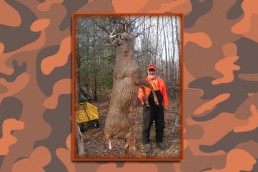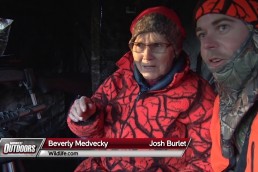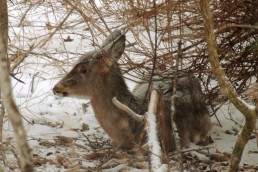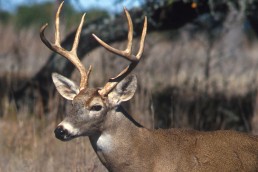Nordberg on Deer: Summer Deer Country Chores
SHARE THIS POST
This month, my deer hunting partners and I will head north for a few days of walleye fishing and some brief chores in our nearby deer hunting area. Though abundant and ravenous mosquitoes, gnats, deer flies and wood ticks will likely be waiting for us in the woods, we are anxious to find certain clues that will reveal what to expect while hunting bucks this fall. We’re hoping our area is certain to be in a “bucks-only” hunting region again this year. Winter losses should have been minimal during our past, unusually mild and short winter. Most of our older does should therefore have given birth to twin fawns last month, likely improving hunting for mature bucks a few years from now. What we most want to know right now is the current state of our remaining mature bucks.
As always, the number one question on our list at this time of the year is, “Are known bucks that were not hunted or not taken last November still alive and living within their previously established home ranges?” It usually doesn’t take long to find out. A quick scout through each of their home ranges usually turns up a few fresh buck-sized tracks and/or droppings that answer this question.
Number two is, “Have mature bucks adopted ranges of mature bucks taken during our previous hunting season?” Because our severe winters of 2012-13 and 2013–14 had reduced our deer numbers by approximated 67 percent, there probably weren’t many two-year-bucks searching for their first exclusive home ranges after snowmelt this past spring, but we are hopeful. My son Dave’s trail cams revealed we had at least two yearling bucks (forkies) in our hunting area last November, which would be two-year-olds now. Hopefully this reflects the state of deer numbers all around our hunting area, improving the chances these empty ranges will be filled now. A quick scout for adult-buck-sized tracks and/or droppings in those ranges should answer this question. It would be nice to be able to look forward to our next hunting season knowing we have our usual number of mature bucks to hunt so we can again justify taking our usual, self-impose limit of four mature bucks. If those four ranges are not home to four new mature bucks by now, we might have to consider taking fewer bucks this year.
A third question that needs answering this year is, “Are there any deer now living in the 50 percent of our hunting area that was found virtually devoid of whitetails and deer signs last November?” Whereas we probably shouldn’t expect these areas to be adopted by new whitetails any time soon, it sure seems strange to have so many spots that were once so reliable for seeing does with young (deer we never hunted) so vacant in recent years. Discovering one fresh track or fresh dropping made by one deer of any kind in any one of these areas will be a reason to celebrate.
Whenever we scout, we also make it a rule to visit most feeding areas (graze and browse areas) and adjacent trails previously frequented by whitetails. The trouble with whitetail feeding areas is, most do not remain whitetail feeding areas forever. I only know of three areas that were favorites of deer in my current study/hunting area in 1990 that are still favorites today. Two are sizable stands of red oaks where whitetails still gorge on acorns when available. The other is on a steep slope covered with mature aspens, a site where red osiers (red-bark dogwoods)—a favorite winter browse of Minnesota whitetails—have no right to be so abundant. Two spots that are four-year-old clearcuts now, where whitetails could always be seen feeding two to three years ago are now smothered with second-growth quaking aspens, some ten feet tall. There so overgrown that the osiers and sugar maple saplings the deer used to browse on can no longer be seen. Many hunters believe whitetails browse on woody stems of quaking aspen saplings but nothing could be further from the truth. Bark of these saplings is extremely bitter (rich with tannin). Moose might like them but whitetails do not.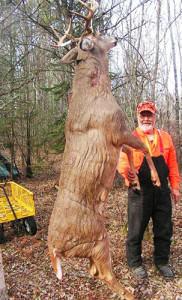
Clearcuts generally provide whitetails with the most abundant of nourishing wild foods, from green vegetation to woody browse. However, not all of them do, and even where such foods are available, the period during which they are present is generally short-lived.
Within three to four years, a huge percent of most whitetail foods growing in a new clearcut can be smothered out by dense, rapidly growing trees. It can then take eight to ten years for the timber to thin out enough to allow enough sunlight to reach the ground to allow favorite whitetail foods to begin growing again. One clearcut that was logged 15 years ago was just becoming suitable habitat for whitetails (one my favorite new places to hunt bucks), when our two severe winters practically wiped out all deer living in its vicinity. Another 40-acre aspen-smothered clearcut in my study that was logged 26 years ago has not yet become suitable habitat and whitetails are still avoiding it.
Are you enjoying this post?
You can be among the first to get the latest info on where to go, what to use and how to use it!
Wolves can also cause some unexpected changes in feeding areas. They have convinced whitetails in my study/hunting area to avoid feeding in all but a few narrow sections of big clearcuts logged three years ago.
A couple of sites I recently noticed on aerial photographs provided by Earth Flash on the internet also need a quick scout—one never hunted before and the other a previous hotspot across a wide spruce bog that has not been hunted for seven years. Spots never hunted before (one not hunted for seven years certainly qualifies) almost always provide opportunities to take mature bucks the first day or two they are hunted.
We also plan to set out mineral blocks. This year, we will be a month late providing our whitetails with 50-pound, cattle-type mineral blocks (minerals with traces of salt, not salt with traces of minerals) because some of the sites (all placed in feeding areas) where we have placed them in the past are either no longer feeding areas or they are in areas no longer inhabited by whitetails (because of severe winters). We therefore need to scout for new places to put them.
We discovered, via a 20-year study, in my first whitetail study area where we proved mineral blocks, it not only increase the mass of antlers of mature bucks by 10 to 20 percent, but most yearling bucks in areas where they normally grew spikes become fork-horns or better. Moreover, we further discovered that the numbers of fawns born and numbers of fawns that survived their first year improved as well. We therefore wouldn’t dream of starting any year without providing our whitetails with mineral blocks. Mineral blocks, by the way, are not bait during hunting seasons. Bucks are typically uninterested in them after antler growth is complete and does are equally uninterested in them after fawns have quit suckling.
As exciting as the walleye fishing in our nearby puddle will probably be (it usually is), you might not understand why my sons and I are nonetheless anxious take time off the water for a dark-to-dark day of feeding ticks and deer flies in the woods, especially at this time of the year. As we’ve learned so often in the past, however, preliminary scouting like this will make it much easier to zero in and finish preparations for hunting specific bucks two to three weeks before our next deer hunting begins this fall, typically an exhausting four-day ordeal at best without early scouting.
Dr. Ken Nordberg has written more than 700 magazine articles and 12 books on the habits and hunting of whitetails and black bears, including the soon-to-be published 10th edition of “Whitetail Hunters Almanac.” He also produced “Doc’s Buck and Bear Hunting School” videos. His encyclopedic website is at drnordbergondeerhunting.com.
MWO
SHARE THIS POST
Did you enjoy this post?
You can be among the first to get the latest info on where to go, what to use and how to use it!
Dr. Ken Nordberg
Based on his 55 years of field research, Dr. Ken Nordberg has written more than 800 magazine articles, 12 books on whitetails—including the famous Whitetail Hunter’s Almanac series—five books on black bear hunting and produced Buck and Bear Hunting School videos. You may peruse his encyclopedic website with whitetail hunting tips: drnordbergondeerhunting.com, his blog: drnordbergondeerhunting.wordpress.com, or social media pages.
